
Guests
- Abdul-Aliy Muhammadorganizer and writer in West Philadelphia who co-founded the Black and Brown Workers Cooperative.
- Mike Africa Jr.second-generation MOVE member and host of the podcast On a Move with Mike Africa Jr.
This week marks the 36th anniversary of the day the city of Philadelphia bombed its own citizens. On May 13, 1985, police surrounded the home of MOVE, a radical Black liberation organization that was defying orders to vacate. Police flooded the home with water, filled the house with tear gas, and blasted the house with automatic weapons, all failing to dislodge the residents. Finally, police dropped a bomb on the house from a helicopter, killing 11 people, including five children. The fire burned an entire city block to the ground, destroying over 60 homes. But the tragedy didn’t end on that day. We look at how Princeton and the University of Pennsylvania have used bones from one or two of the murdered children in their classes for years. “We still don’t know all the details about what happened in terms of the chain of custody,” says Abdul-Aliy Muhammad, an organizer and writer in West Philadelphia who helped bring the revelations to the public. “You can’t even begin to heal because the harm is still being done,” adds Mike Africa Jr., a second-generation MOVE member. “Everybody is just retraumatized.”
Transcript
AMY GOODMAN: “Fly Baby” by Mike Africa Jr., featuring Suzann Christine. He says that when his mother came home from prison after 40 years, she told him to be free and “fly baby.” Debbie Africa and Michael Africa Sr. are in that video, as well.
This is Democracy Now!, democracynow.org, The Quarantine Report. I’m Amy Goodman in New York, with Juan González in New Brunswick, New Jersey. By the way, you can sign up for our daily news digest by sending the word “democracynow” — one word, no space — texting it to 66866. Text “democracynow” to 66866.
We spend the rest of the hour on a story Democracy Now! has been following for decades, and again more intensively this past month as Philadelphia’s racist past resurfaced with the public disclosure that the bones of one or two African American children killed by the city’s police in 1985 are being used in an online Princeton University course called “Real Bones: Adventures in Forensic Anthropology.” These bones were being used without the knowledge of their families.
This Thursday, May 13th, marks the 36th anniversary of the day the city of Philadelphia bombed its own citizens. On that day in 1985, police surrounded the home of MOVE, a radical Black liberation organization that was defying orders to vacate. Police flooded the home with water, filled the house with tear gas, blasted the house with automatic weapons — all failing to dislodge the residents. Finally, police dropped a bomb on the house from a helicopter, killing 11 people — six adults and five children. The fire burned an entire city block to the ground, destroying over 60 homes. This is how the bombing was initially reported in Philadelphia on WCAU-TV.
WCAU ANCHOR: I’ve just been advised that we have new videotape of the episode that apparently ended — we think ended — the MOVE situation tonight, the dropping of an incendiary device. And let’s take a careful look at this. 5:27 p.m., state police helicopter drops it. There is the explosion. As you can see, a very dramatic explosion that occurs 30 seconds and really rips into the MOVE compound. There you see the bunker, which soon will go up in flames. And that was the explosion close up. Now, if there’s anybody there standing there, it’s obvious they couldn’t survive that explosion.
AMY GOODMAN: So, that was May 13th, 1985. The police bombing came after an earlier standoff with MOVE in 1978 ended in a hail of police gunfire, leaving one police officer dead. MOVE members say they didn’t fire a shot and that the officer, that the victim — the officer was a victim of friendly fire. Former Mayor of Philadelphia Wilson Goode concurred with that conclusion. Nevertheless, nine of them were convicted of his murder and given life sentences. One of them, Debbie Africa, secretly gave birth in her cell just five weeks into her sentence. She managed to keep her son, Mike Africa Jr., with her for three days before alerting the guards. Seven of the MOVE 9 are now free, after serving 40 years. Two died in prison.
In a minute, we’ll be joined by Mike Africa Jr. Last month, Philadelphia activist and writer Abdul-Aliy Muhammad learned the bones from one or two of the children killed by the police in that 1985 MOVE bombing, Tree and Delisha Africa, were being used by Princeton University and the University of Pennsylvania’s Penn Museum of Archeology and Anthropology in an online video course. In the video, Penn Museum curator Janet Monge handles the bones and calls them, quote, “juicy,” meaning that you can tell that they’re of a recently deceased individual, she said.
This comes as press accounts from 1985 say that Tree’s remains — she was 14 — were buried along with those of her half-sister Zanetta not long after the conclusion of an official inquiry. The remains of the other children, including Delisha, were reportedly handed over to a state senator who ran a funeral home and had them buried in unmarked graves. But if the bones of Tree and Delisha were buried in 1985, how did they end up in Janet Monge’s hands 36 years later?
Well, for more on these developments and what the children’s families are calling for, we’re going to Philadelphia to speak with Abdul-Aliy Muhammad, who helped reveal how the remains were being used after they first called for the Penn Museum to repatriate the skulls of enslaved people held in its Morton Collection. Also joining us, Mike Africa Jr., host of the podcast “On a Move with Mike Africa Jr.” and co-author of the new book Fifty Years ona Move.
We welcome you both to Democracy Now! Abdul-Aliy Muhammad, let’s begin with you. I mean, your reporting on what has happened to these bones in The Philadelphia Inquirer and other places is key to understanding what’s taken place. How is it possible that Princeton and the University of Pennsylvania have been using these bones to educate students about, what, adventures in anthropology?
ABDUL-ALIY MUHAMMAD: I mean, it’s gross. You ask how is it possible. We still don’t know all the details about what happened in terms of the chain of custody of the bodily remains of Tree and Delisha Africa. What we know, according to archival research and the work that I have been doing, is that in the days after the bombing, the days after the state murder of 11 people, 11 Black people in Philadelphia, Alan Mann, who was a professor at Penn, who was a bioanthropologist, was hired by the Medical Examiner’s Office to help in determining who the remains belonged to, because, like you said earlier in this segment, that the bomb then burned, causing a destruction of two city blocks, the killing of 11 people. The city, in its efforts to get the remains from the crime scene in the days following, basically used machinery and mangled bodies, instead of carefully gathering the remains of people. And so, the medical examiner needed help in figuring out who these remains belonged to. Alan Mann was hired by the Medical Examiner’s Office to work for a day and some change to help identify remains. And Janet Monge was a Ph.D. student at the time, and so assisted Mann in helping identify remains.
Their conclusion was that there were seven adults and four children, which we now know is inaccurate. You know, months later, Mayor Goode, Mayor Wilson Goode, creates the MOVE Commission to look into the events and the bombing. The MOVE Commission hires a forensic specialist named Dr. Ali Hameli from Delaware. Dr. Ali Hameli examines the remains and concludes in a report that there are the remains of six adults and five children. And we know, from archival — from archival, you know, information and documentation, that Hameli has to reexamine the remains because Mann challenges the findings in the press. So, now Hameli reexamines the remains in November of 1985 with two other people and reaffirms his earlier report, which is that these remains are of five children and six adults, and the remains that were said to have been unidentifiable belonged to Tree Africa. And there were some other remains that there were questions about, and Hameli says these remains belong to Delisha Africa.
What the commission does after that is send a memorandum to the Medical Examiner’s Office to release the remains per the normal procedures of that office. So, we are — I’m just mind-blown at the fact that 36 years later these remains pop up on a video to teach about anthropology.
JUAN GONZÁLEZ: Well, Abdul-Aliy Muhammad, I wanted to ask you — in terms of this Morton Collection itself and the University of Pennsylvania, Morton was celebrated as a founder of American ethnography, but he was actually a white supremacist. Could you talk about this whole issue, this scandal of these institutions continuing to hold the bones, many of them of enslaved Africans and of Native Americans, as well?
ABDUL-ALIY MUHAMMAD: Yeah, sure. I mean, like you said, Morton was a white supremacist physician who amassed a collection of skulls in the late 1700s and 1800s. And Morton’s research, or race science, was based on this notion that humans had different ancestors — right? — that different races had different ancestors. And he tried to posit the idea that you could tell the intellectual capacity of a race by measuring skulls.
And so, to do his scientific work, he would purchase skulls from plantations. There are skulls that were grave-robbed from a local potter’s field in Philadelphia of 14 Black Philadelphians. Their remains were stolen. And this collection, like you said, has Indigenous folks, has poor white people. And his science was basically trying to legitimize the institution of slavery by stating that, you know, Black folks and other people, like Indigenous people, had less capacity for intellectual thought than white people.
And so, about two years ago, I started calling for the repatriation of the remains housed in the Morton Collection. And that escalated. And then, around the uprising, Police Free Penn formed, calling again for repatriation, for the abolition of policing on campus. And in that context, they restated my demand for repatriation. Penn then creates a committee to consider the question of repatriation and reburial, and there was more momentum around this conversation.
Then, almost a year later, Paul Wolff Mitchell, a Ph.D. student, then identifies, oh, they don’t just have the 53 crania that we originally thought they had — right? — 51 crania from a plantation in Cuba, in Vedado, and then two from Black folks in the U.S. They additionally have 14 crania of Black Philadelphians grave-robbed from Franklin Field, which is a part of Penn’s campus. It’s an athletic field that used to be a burial site.
And so, when that happened, it reignited the call for repatriation. There was a protest, and there were demands stated at that protest to repatriate the remains or, if they can’t be repatriated, to give them to descendant communities to bury them. And after that happened, that’s when the story came to me about Penn’s possession, Penn Museum’s possession of Tree and Delisha’s remains.
JUAN GONZÁLEZ: I’d like to bring in Mike Africa Jr. to the conversation. Mike, how are the families and the MOVE community processing and responding to these latest developments on what happened with the remains of two of the children in the bombing?
MIKE AFRICA JR.: Well, first of all, thank you for having me on the show to put out this information.
The people in our family, as you can imagine, are still very shaken up and disturbed and traumatized, retraumatized. You know, we were supposed to do this thing this year because of the City Council — City Councilwoman Jamie Gauthier pushed for an apology from the city, City Council and the city of Philadelphia, for dropping the bomb. And there was this, like, possibility, possible opportunity, to, like, really start talking about how we can reconnect and recommit and reobserve and all of these things for what happened on May 13th, 1985. And although we never forget about what happened, just going back to that day to try to learn from it so that it never happens again, you know, it’s like one of these things where you can’t even begin to heal because the harm is still being done. And so, like, everybody is just retraumatized and have to relive May 13th all over again. And to find out this happened to two of the children, you know, it’s devastating. It gives me the creeps just listening to the reports about what happened to our sisters. Everybody in the family are just — just stuck right now.
AMY GOODMAN: In fact, Mike, you knew Tree, you knew Delisha. You lived and played with them on a farm in Virginia?
MIKE AFRICA JR.: Yeah, I did. We lived for years, for years together. See, the thing is, we were all like unconventional orphans, right? All of our — our parents were in prison, and so we were always together, because the people, the other people, the caretakers of the organization, they took us in, because, like, my parents were in prison, just like Tree’s mother was and just like Delisha’s parents were. You know, so, yeah, we were always together. We were always doing everything together, eating together. We played together. We cried together. We were in fear together. You know, to hear about this, it’s devastating.
JUAN GONZÁLEZ: And, Mike, in your book that you’ve written, Fifty years ona Move, you talk about the history of the relations between MOVE and the political establishment and the police department in Philadelphia. And as you know, I was a young reporter back then in Philadelphia at the time. I lived through the ’78 confrontation and the killing of Officer Ramp — which obviously was from police fire, not from the MOVE compound then — and then, of course, the 1985 bombing, as well. Could you talk about the situation back then, especially under Mayor Rizzo, Frank Rizzo? I recall after the ’78 shootout, when Delbert Africa was publicly beaten in the streets almost senseless by a group of police officers, that the head of the NAACP at the time, Alphonso Deal, who later became a state representative, said at that time — he publicly called for an investigation of police abuse, and Mayor Rizzo went on the 6:00 news and said, “As for Al Deal, I want a piece of him myself.” That was the kind of mayor that Frank Rizzo was back then. And could you talk about the climate and how MOVE became a lightning rod of police abuse in those days?
MIKE AFRICA JR.: You know, much like the Black Panthers and other organizations that wanted to see change, that’s what MOVE was doing. That’s when John Africa was about, trying to make some kind of change because of the conditions of Black people’s living, and not just Black people, but poor whites and animals and the environment. You know, we needed change. And that message was so, like, strong.
And when you try to make change, when you try to do something to upset the current establishment and try to just take us in a new direction because what’s happening is wrong, they don’t want these things to change. They want to stay in this position, in this position of power, in this position of control. And so, when anybody tried to speak up, it ain’t just MOVE that will run into these obstacles and this wall of police and this wall of politicians just trying to stop you from putting out this information. And so, that’s exactly what MOVE — Rizzo was like Donald Trump, you know, of that time, except he was even worse in that confined space.
AMY GOODMAN: Mike Africa Jr., we have to leave it there. I know your family will be doing something on Thursday, on the anniversary of the, 36 years ago, the police killing —
MIKE AFRICA JR.: That’s right.
AMY GOODMAN: — 11 people in the MOVE family. I’m Amy Goodman, with Juan González. Mike Africa and Abdul-Aliy Muhammad, thank you.

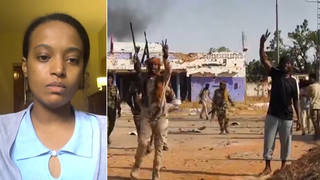
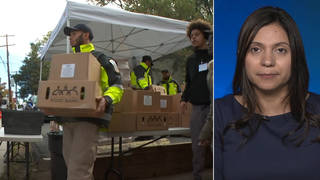
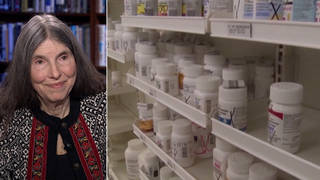
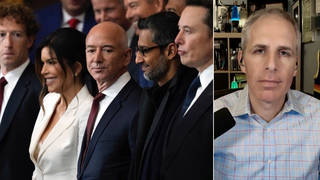





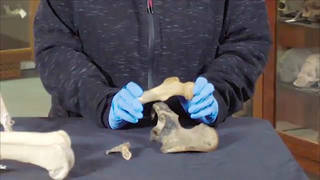

Media Options